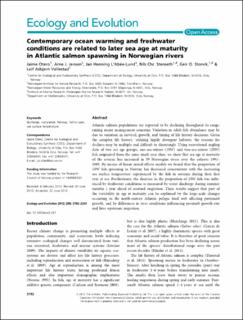| dc.description.abstract | Atlantic salmon populations are reported to be declining throughout its range, raising major management concerns. Variation in adult fish abundance may be due to variation in survival, growth, and timing of life history decisions. Given the complex life history, utilizing highly divergent habitats, the reasons for declines may be multiple and difficult to disentangle. Using recreational angling data of two sea age groups, one-sea-winter (1SW) and two-sea-winter (2SW) fish originated from the same smolt year class, we show that sea age at maturity of the returns has increased in 59 Norwegian rivers over the cohorts 1991–2005. By means of linear mixed-effects models we found that the proportion of 1SW fish spawning in Norway has decreased concomitant with the increasing sea surface temperature experienced by the fish in autumn during their first year at sea. Furthermore, the decrease in the proportion of 1SW fish was influenced by freshwater conditions as measured by water discharge during summer months 1 year ahead of seaward migration. These results suggest that part of the variability in age at maturity can be explained by the large-scale changes occurring in the north-eastern Atlantic pelagic food web affecting postsmolt growth, and by differences in river conditions influencing presmolt growth rate and later upstream migration. | en_US |
